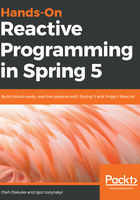
上QQ阅读APP看书,第一时间看更新
Configuring asynchronous support
To run everything, we need an entry point for our application with the following customized methods:
@EnableAsync // (1)
@SpringBootApplication // (2)
public class Application implements AsyncConfigurer {
public static void main(String[] args) {
SpringApplication.run(Application.class, args);
}
@Override
public Executor getAsyncExecutor() { // (3)
ThreadPoolTaskExecutor executor = new ThreadPoolTaskExecutor();// (4)
executor.setCorePoolSize(2);
executor.setMaxPoolSize(100);
executor.setQueueCapacity(5); // (5)
executor.initialize();
return executor;
}
@Override
public AsyncUncaughtExceptionHandler getAsyncUncaughtExceptionHandler(){
return new SimpleAsyncUncaughtExceptionHandler(); // (6)
}
}
As we can see, the example is a Spring Boot application (2), with an asynchronous execution enabled by the @EnableAsync annotation (1). Here, we may configure an exception handler for exceptions thrown from the asynchronous execution (6). That is also where we prepare Executor for asynchronous processing. In our case, we use ThreadPoolTaskExecutor with two core threads that may be increased to up to one hundred threads. It is important to note that without a properly configured queue capacity (5), the thread pool is not able to grow. That is because the SynchronousQueue would be used instead, limiting concurrency.